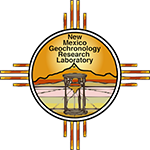Rocks deform—that is they rotate, change shape, or are displaced—as a result of the movement of tectonic plates. At Earth’s surface, one of the ways deformation manifests is in slip along fault zones that generates earthquakes. Rocks deform—that is they rotate, change shape, or are displaced—as a result of the movement of tectonic plates. At Earth’s surface, one of the ways deformation manifests is in slip along fault zones that generates earthquakes. Fault zones continue downwards into the Earth where they are called ductile shear zones; at depths greater than ~12 km higher temperatures and pressure cause rocks to deform without fracturing. Constraining the timescales of deformation in such ductile shear zones remains a challenging task. Geologists continue to seek reliable "deformation chronometers", meaning geochronologic technqiues that enable direct dating of deformation.
The purpose of this collaboration with Amy Moser (MIT), Alexander Lusk (USGS), and Joshua Garber (Penn State) is to determine the meaning of U-Pb age data from titanite grains directly involved in intense ductile deformation within localized shear zones can be as such a deformation chronometer. The mineral titanite (CaTiSiO5) is an exciting candidate as it is a common mineral in igneous and metamorphic rocks that may be deformed in ductile shear zones. By measuring the amount of radioactive uranium (U) that has decayed to radiogenic lead (Pb), geochronologists can estimate the date at which the mineral crystallized or was deformed. Whether or not titanite can be used as a deformation chronometer is best answered in ductile shear zones with a simpler history where the timing of deformation has been tightly constrained by other means.
Ductile shear zones of Laramide age are exposed in the Cottonwood area of Joshua Tree National Park in eastern California. This area is an ideal locality to tackle this problem as: (1) ductile shear zones that deform titanite-bearing rock are exposed at the surface; (2) the deformed rocks are plutonic with a limited tectonic history, and thus all deformation in a titanite grain can be attributed to a single tectonic event; and (3) the deformation age of the shear zones is well-constrained by previously analyzed ages of crosscutting rocks that provides tight, but still relative age constraints. Sample collection, structural characterization, and geochronology analyses are ongoing! Preliminary work has been presented at recent conferences (e.g. AGU 2018, AGU 2021, GSA C/RM 2022).
A deeper understanding of the spatiotemporal patterns of Laramide deformation across the entire western United States Cordilleran orogen is an ongoing scientific and societal interest for New Mexico geology, with recent related papers by Economos et al. (2021) and Schwartz et al. (2023).
For more information, contact:
Dr. Snir Attia— Field Geologist
Results
- Moser, A.C., Lusk, A.D., Attia, S., Garber, J.M., Seward, G.G.E., and Kylander-Clark, A.R.C., 2023, Titanite petrochronology dates secular temperature and fluid evolution during ductile deformation: an example from Late Cretaceous shear zones in the Eastern Transverse Ranges: Geochemistry, Geophysics, and Geosystems, 24, e2022GC010855.
Moser, A.C., Lusk, A.D., and Attia, S., 2022, Dating deformation with titanite: an example from Cretaceous shear zones in Joshua Tree National Park: Geological Society of America Abstracts with Programs, 54, 2.
Moser, A.C., Hacker, B.R., Cawood, T.K., Gehrels, G.G., Lusk, A.D., and Attia, S., 2021, U-Pb Dates from Dynamically Recrystallized Titanite Directly Constrain Timing of Crystal-Plastic Deformation: AGU Fall Meeting, Abstract V22A-05.
Lusk, A.D., Schmidt, W.L., Cawood, T.K., Platt, J.P., Hervig, R.L., Attia, S., Behr, W.M., and Paterson, S.R., 2018, Trace element distribution and mobility in naturally-deformed quartz: AGU Fall Meeting, abstract MR41B-0057.
References
Economos, R.C., Barth, A.P., Wooden, J.L., Paterson, S.R., Friesenhahn, B., Wiegand, B.A., Anderson, J.L., Roell, J.L., Palmer, E.F., Ianno, A.J., and Howard, K.A., 2021, Testing models of Laramide orogenic initiation by investigation of Late Cretaceous magmatic-tectonic evolution of the central Mojave sector of the California arc: Geosphere, 17, 6, 2042–2061.





